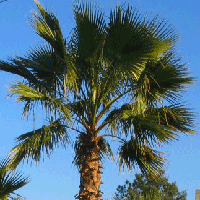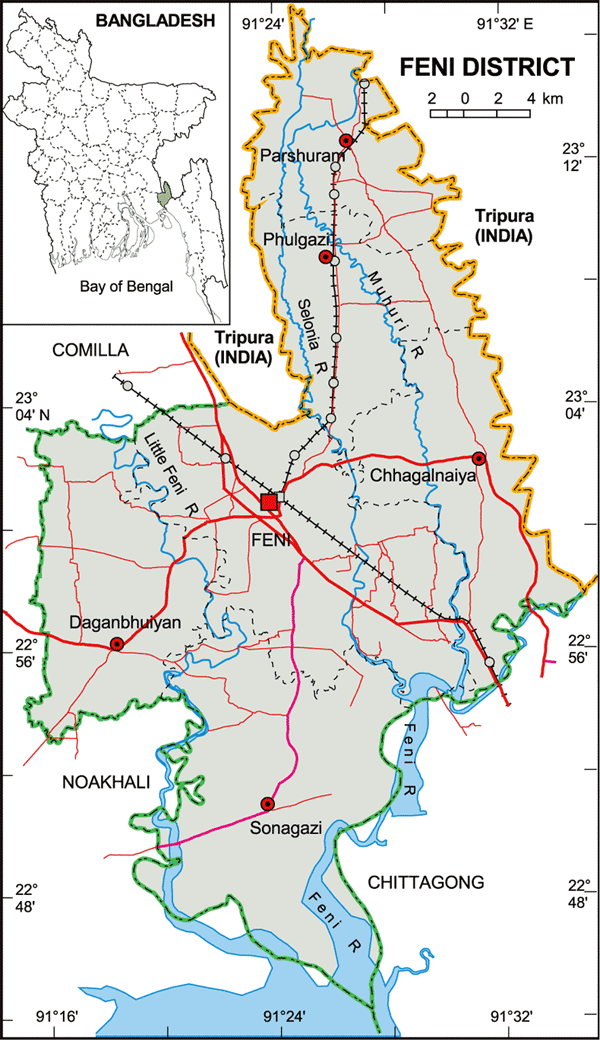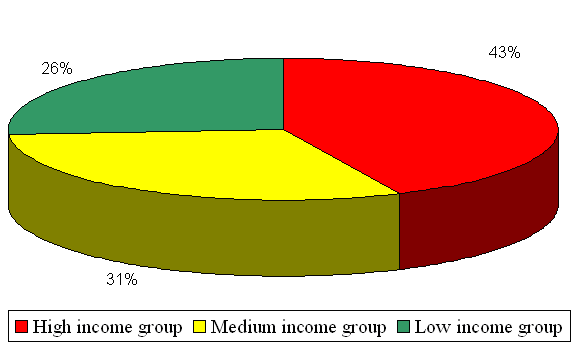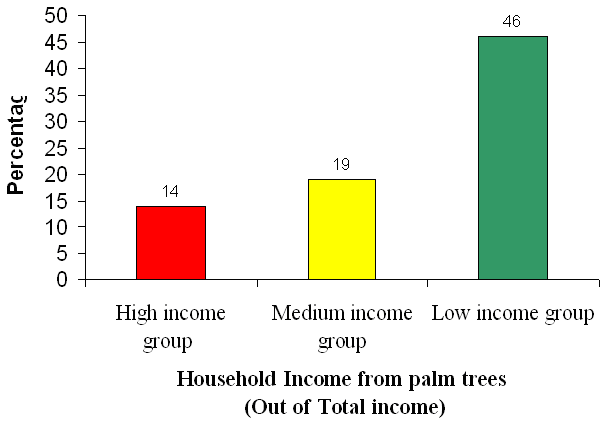
The role of palm husbandry in the rural economy of the south-eastern region of Bangladesh
iForest - Biogeosciences and Forestry, Volume 3, Issue 2, Pages 39-43 (2010)
doi: https://doi.org/10.3832/ifor0528-003
Published: Mar 02, 2010 - Copyright © 2010 SISEF
Research Articles
Abstract
An exploratory study was conducted in Feni, a south-eastern district of Bangladesh to explore the role of palm husbandry in the rural economy. A total of 48 households in the study area were interviewed using a semi-structured questionnaire. Based on the total annual income, the farmers were categorized into three groups as high-income group, medium income group and low-income group. Palm tree contributes 26.000 Tk, 22.740 Tk and 18.300 Tk respectively to the three-income group annually (1 US$ = 69 Tk). Palm trees contribute 46% of total annual income to low-income group followed by 19% to medium income group and 14% to high-income group. Incase of overall income of all the respondents, 26% income comes from palm trees. Besides this, palms provide a multitude of useful products ranging from fuelwood to materials for construction, tools and handicrafts. However the poor marketing system result in decreasing the annual return from palm trees. Palm husbandry could be a promising source of rural incomes in Bangladesh if the farmers’ traditional management knowledge was linked to more scientific management practices.
Keywords
Introduction
Palm is one of the important horticultural crops in many countries. The palm family (Palmae, or more recently Arecaceae), with some 2200 species, is distributed throughout the tropics and subtropics ([29]); representing an integral and important part of tropical forests ([28]). Situated in the tropical region, Bangladesh also houses a number of palms distributing from hilly topography through plain lands to the muddy mangrove forests ([15], [24]). Palm is one of the important horticultural crops in many countries ([27], [30]). In Bangladesh at least 20 species of palms grow naturally (Pasha s.d.). The most common types of palm tree available in Bangladesh are Date palm (Phoenix sylvestris), Palmyra palm (Borassus flabellifer), Betel nut (Areca catechu) and Coconut (Cocos nucifera). Presently these trees are scatteredly grown all over Bangladesh. In Bangladesh very little attention is paid for the systematic cultivation of palm for better yield. A significant economic return is possible from the cultivation of palm ([19]).
The great economic palm in Bangladesh is coconut (Cocos nucifera) (Pasha, s.d.). It is one of the most important homestead and plantation crops of Bangladesh with multipurpose uses ([34], [18]). The Palmyra palm (Borassus flabellifer) is locally known as Tal and tender Tal is known as Daab. This species also have multipurpose uses ([25]). In Bangladesh Betel nut (Areca catechu) are commonly produce along pond bank, roadside in the village area, homestead areas and along canal bank. Betel nut may be chewed alone, but the usual practice is to wrap small slices or pieces of the nut in a leaf of betel piper, to which lime is added. It is chewed after meals and on all special occasions (Islam s.d.). In Bangladesh, date palm (Phoenix sylvestris) is produced as a homestead crop; however, it grows naturally or is cultivated in fallow lands, around homesteads, farmland boundary and even in the marginal lands along the roads and canals ([8]). In the crop fields, the palm is found on the Ails (slightly raised embankments used as border of crop fields) and also within the fields along with other crops ([1]). Sap from P. sylvestris has been used from time immemorial to produce traditional sweeteners, a mainstay of Bengali cuisine ([2]). Because of the extensive use of its sap in making sugar, it is of considerable importance for household economy in Bangladesh, where cultivation of the palm for tapping is an age-old practice ([31]). About 85% people are living in the villages and depend mainly on agriculture and tree-based products ([14]). Since rural household incomes depend mainly on agriculture, landholdings determine the household economy. The rural poor households particularly depend on tree or other plant-based economic activities for their subsistence ([21]). Dalibard ([17]) identified various types of palm-crop associations in Bangladesh, which in the words of [26] is a strong evidence of multiple land uses to meet the growing needs for the growing people. The rural farmers of south eastern Bangladesh depend upon palm husbandry for their seasonal livelihoods. The present study explores its socio-economic contribution to rural Bangladesh.
Materials and Method
Study Area
The study was conducted at Farhad Nagar union (a rural administrative unit consists of a number of villages) of Feni Sadar upazila (sub-district; administrative entity) of Feni district, south-eastern region of Bangladesh (Fig. 1). Feni Sadar upazila occupies an area of 197.33 km2, is bounded by Chauddagram, Tripura (India), Parshuram and Chhagalnaiya upazilas on the north, Sonagazi and Mirsharai upazilas on the south, Chhagalnaiya upazila on the east, Daganbhuiyan upazila on the west ([13]). The area is located in an important strategic focal point between 22°56’-23°04’ N and 91°22’-91°30’ E. Total cultivable land 18122.66 hectares; fallow land 249.89 hectares; single crop 6.95%, double crop 83.95% and treble crop land 9.10%. Main crops are paddy, wheat, pulses, sweet potato, chili, sugarcane and groundnut. Extinct or nearly extinct crops are jut and sesame (til). Main fruits are mango, jackfruit, banana, date, palmyra, coconut, etc. ([13]). In the upazila, 25.46% of the total households depend on agriculture as the main source of household income, agricultural labourer 9.62%, wage labourer 2.03%, transport 5.45%, industry 1.42%, construction 1.77%, commerce 18.34%, service 20.8% and others 15.11% ([13]).
Fig. 1 - Location map of the study area ([12]).
Methods
Palm tree species are one of the major plantation trees for their fruits and sap collection in the south-eastern region of Bangladesh (Pasha s.d.). There are about five districts in the south-eastern region of Bangladesh where palm trees are very much concentrated. A deliberate sampling method was used to locate the Feni district from the five districts of south-eastern region of Bangladesh. From a total of six upazila, Feni Sadar upazila was selected purposively. The rationale behind the selection of this site because of the availability of palm trees. A multistage random sampling method was applied to locate the villages and households for the study within the upazila as the primary sampling unit and ultimate sampling unit respectively. From a total of 16 unions of Feni Sadar upazila, one union (Farhad Nagar union) was selected randomly and from the union, one village was selected using the same sampling technique. Then a list of palm tree cultivators was prepared from the village and 48 households (20% sampling frequency) were selected randomly for survey and interviewed using a semi-structured questionnaire. Based on the total annual income, the respondents of the study area were categorized into three groups such as high-income group, having total annual income more than 140 000 Tk, medium income group, having total annual income range of Tk 80 000- Tk 139 000 and low-income group, having total annual income of not more than Tk 79 000 (Tk: Taka, Bangladesh currency; 1 US$ = 69 TK). Some 16 households were selected from each group. Data were collected from different aspect such as data on demographic conditions; occupations and contributions of palm were collected through interview using questionnaires to fulfil the objectives of the study. On each topic the respondents were free to express their views.
Results and discussion
Socio-economic and demographic features
Demographically, in our sample village average family size was 9.5. The average family size was maximum i.e.12 in high-income group followed by 7.5 in medium income group and 9 in low-income group. Besides this, the average-earning member of family was also maximum, i.e., 29% in high-income group followed by medium income group (26%) and low income group (16%). The literacy rate of the study area was 88.65%. The primary occupation in our study area is servicing abroad (38%), followed by business (13%), other profession (49%) such as teaching, agriculture, construction, labour, etc.
Possession pattern of palms tree species
Of the total 560 palms studied, farmers of high-income group possessed 240 individuals (43%), which was the highest value among the different groups and the low-income group possessed only 144 individuals (26%), which was the lowest value (Fig. 2).
Production cost and prices of various palm products
The prices of the different products produced from palm vary seasonally and on the basis of locality of the enterprises. The price of the product varies with size, quality and local demand ([35]). Tab. 1 shows average production cost, average selling cost, average profit and the expected income from different palm tree species products per tree per year. The formula used here is adapted from Vishwakarma et al. ([36]), Ahmed et al. ([3]); Alamgir et al. ([4]), [5], [6], [7]. From the view point of net average profit per unit, date palm sap was accounted for the highest value (Tk 12) followed by coconut (Tk 9.37). Annual expected income per tree was also highest for date palm sap (Tk 2400) followed by coconut (Tk 750). Date palm was accounted for the highest value (1000) in number of unit sold annually followed by date palm sap (200 liter), bettle nut (120). The least value in net profit per article (Tk 0.22) was found for date palm fruit.
Tab. 1 - Average production cost per unit, average selling price per unit, net average profit per unit, average production (fruit) in amount (unit) per tree per year and income (TK) per tree per year. Tk 69 = 1US$; (*): includes production cost and transportation cost.
| Palm product (Fruit and sap) | Average Production (Fruit) in amount (unit) per tree per year | Average production cost (Tk.) per tree per year | Average selling price per unit (Tk.) | Net average profit per unit (Tk.) | Income (TK) Per tree per year |
|---|---|---|---|---|---|
| Coconut | 80 | 50 | 10.00 | 9.37 | 750 |
| Bettle nut | 120 | 20 | 1 | 0.83 | 100 |
| Palmyra palm | 110 | 25 | 5 | 4.77 | 525 |
| Date palm (Fruit) | 1000 | 30 | 0.25 | 0.22 | 220 |
| Date palm (Sap) | 200 (liter) | 600 | 15 | 12 | 2400 |
Contribution of palm tree species in total annual income
Palm husbandry is one of the important means of livelihoods in rural Bangladesh. It plays an active role in the contribution to rural economy, to the cultural heritage of the countrymen as well ([20]). A significant economic return is possible from the cultivation of palm ([19], [33]). Our study revealed that the total average annual income for high-income group was 180 000 Tk followed by medium income group (120 000 Tk) and low-income group (40 000 Tk). Palm tree contributes 26 000 Tk, 22 740 Tk and 18 300 Tk, respectively, to the three-income group annually (Tab. 2). By selling of palm products the farmer can uplift their socio-economic condition. This finding also agrees with the findings of FAO ([20]), Dowson ([19]) and Naik ([33]).
Tab. 2 - Total average annual income and net average annual income per households from palm trees.
| Category | Average total Annual Income (TK) | Net Average Annual Income per households from Palm trees |
|---|---|---|
| High income group | 180 000 | 26 000 |
| Medium income group | 120 000 | 22 740 |
| Low income group | 40 000 | 18 300 |
Palm trees contribute 46% of total annual income to low-income group farmers followed by medium income group (19%) and high-income group (14% - Fig. 3). Finally in the study area, palm trees contribute 26% of total annual income of the households (Fig. 4). Halim et al. ([23]) stated that the landless farmers were found to earn the highest mean annual income from the palm husbandry. This reflects a global trend: for instance, Liedholm & Mead ([32]) also found substantial contribution of such sector in the total income. Employment and income from small-scale non-farm enterprise activities, particularly for poor people, are of growing importance in the rural economy of developing countries ([9], [22]).
Multipurpose use of palm trees
Other than fruit and sap production, the palm is also widely used for some other purposes as mat making, fencing ([20]). Palms provide a multitude of useful products ranging from food, to materials for construction, tools and handicrafts ([11], [38]). In the study area, multiple benefits such as fuelwood, thatching material, handicrafts and mats, timber, material for building construction are also obtained from palm tree. The people of the study area were found to make a huge amount of product by using palm materials. By using coconut palm locally known as Narikel, they produce coconut oil, brooms. They also use coconut leaves as fuelwood, for roof thatching, for weaving decorative handicrafts and mats. After the completion of the economic life of a coconut tree, usually 30-35 years, the timber from the straight bole is used for different structural purposes like building construction (e.g., beams, rafters, joists, purloins, banisters, etc.) and boat building, etc. Coconut shells were used for making household utensils, e.g., spoons, hokkas, traditionally in the study area. Dry branches of betel nut are a useful fuel in the rural area. After the completion of the economic life of a betel nut tree, usually 20-25 years, the timber from the straight bole is used for different structural purposes like building construction, manufacture of handicrafts. Branches of palmyra palm (Borassus flabellifer) are used for making hand fan. It is also used for fencing. Immature palmyra palm that is locally known as Daab is a nutritious food. Its branches also can be used as fuel wood. Saps were collected from the inflorescence of palmyra palm, which were used for making toddy. In the study area date palm (Phoenix sylvestris) were widely planted for collecting sap. By boiling date palm sap a mixture locally called Rab were prepared, which has a strong demand for eating with cake. Date palm branches were widely used as fencing materials in the locality, it also used as fuel wood.
Marketing system of the products
According to the farmers’ opinion, majority of the palm products are sold to the local markets through middlemen, Tapper or Gachhi. Some cases they directly sold it in the local market. In case of date palm after collecting the sap from the palm, sometimes it was reported to be shared with the tapers. The farmers opined that while marketing the date palm produces, sometimes sap is sold directly as drink in the local market. There are several problem arises in the marketing of palm products. The local firmer doesn’t get the proper price of their product due to improper marketing system. Sometimes the middlemen get the maximum benefit from the farmer products. This is due to lack of marketing knowledge and available market information as well as marketing facilities. The price variation might be higher than the stated price, as the middlemen generally do not state the real price. Bakht ([10]), Warner ([37]), Halim et al. ([23]) and Chowdhury et al. ([16]) reported the similar barriers of obtaining the information from the middlemen.
Conclusion
The study established that the income of the farmers from palm husbandry is a significant portion of their annual income and plays an important role in the livelihoods in south-eastern rural Bangladesh. The poor people are mostly dependent on the palm for its income. Thus, palm husbandry plays a vital role in supporting rural people in this particular region for their economic uplifting. The farmers are applying solely traditional management knowledge of their own in the farming and management of this resource, exerting a sustainable manner of utilization. Over the past few decades, the importance of farmers’ traditional management knowledge in managing natural resources has gained increasing recognition from the scientific community. Conducting more researches by documentation, exploration and correlation of farmers’ traditional management knowledge with scientific technology could easily be a tool for the improvement of the husbandry as well as conservation of this palm. The sustainable management of the palm on the other hand can upgrade the micro-climatic condition, enriching the vegetation resources of the country. The IUCN Palm Specialist Group has already declared the Palm Action Plan (PAP) with a view to conserve the palms and to explore their utilization worldwide ([16]). It might be the time for the policy makers in Bangladesh to pay their attention to assess the potentials of palm and to extend cooperation to support related research activities for the purpose of adding a feather of success in the crown of the Palm Action Plan
Acknowledgement
Authors are thankful to the rural farmers: without their assistance and cooperation, it would not be possible to reach a proper completion of the study.
References
Gscholar
Gscholar
Gscholar
Gscholar
Gscholar
Gscholar
Gscholar
Gscholar
Gscholar
Gscholar
Gscholar
Gscholar
Gscholar
Gscholar
Gscholar
Gscholar
Gscholar
Gscholar
Gscholar
Gscholar
Gscholar
Gscholar
Gscholar
Gscholar
Gscholar
Gscholar
Gscholar
Authors’ Info
Authors’ Affiliation
Corresponding author
Paper Info
Citation
Rana MP, Islam MS (2010). The role of palm husbandry in the rural economy of the south-eastern region of Bangladesh. iForest 3: 39-43. - doi: 10.3832/ifor0528-003
Academic Editor
Marco Borghetti
Paper history
Received: Nov 03, 2009
Accepted: Jan 18, 2010
First online: Mar 02, 2010
Publication Date: Mar 02, 2010
Publication Time: 1.43 months
Copyright Information
© SISEF - The Italian Society of Silviculture and Forest Ecology 2010
Open Access
This article is distributed under the terms of the Creative Commons Attribution-Non Commercial 4.0 International (https://creativecommons.org/licenses/by-nc/4.0/), which permits unrestricted use, distribution, and reproduction in any medium, provided you give appropriate credit to the original author(s) and the source, provide a link to the Creative Commons license, and indicate if changes were made.
Web Metrics
Breakdown by View Type
Article Usage
Total Article Views: 65631
(from publication date up to now)
Breakdown by View Type
HTML Page Views: 54334
Abstract Page Views: 3549
PDF Downloads: 6697
Citation/Reference Downloads: 23
XML Downloads: 1028
Web Metrics
Days since publication: 5788
Overall contacts: 65631
Avg. contacts per week: 79.37
Article Citations
Article citations are based on data periodically collected from the Clarivate Web of Science web site
(last update: Mar 2025)
Total number of cites (since 2010): 4
Average cites per year: 0.25
Publication Metrics
by Dimensions ©
Articles citing this article
List of the papers citing this article based on CrossRef Cited-by.
Related Contents
iForest Similar Articles
Research Articles
Domestic use of biomass fuel in the rural Meghna floodplain areas of Bangladesh
vol. 3, pp. 144-149 (online: 27 September 2010)
Research Articles
Implications of ecotourism development in protected areas: a study from Rema-Kalenga Wildlife Sanctuary, Bangladesh
vol. 3, pp. 23-29 (online: 22 January 2010)
Editorials
Adaptation of forest landscape to environmental changes
vol. 2, pp. 127 (online: 30 July 2009)
Research Articles
Nutrients (N, P and K) dynamics associated with the leaf litter of two agroforestry tree species of Bangladesh
vol. 2, pp. 183-186 (online: 15 October 2009)
Research Articles
Status and socio-economic significance of wetland in the tropics: a study from Bangladesh
vol. 2, pp. 172-177 (online: 15 October 2009)
Commentaries & Perspectives
Research priorities and opportunities within the forestry and agroforestry sectors in Albania
vol. 3, pp. 113-117 (online: 27 September 2010)
Review Papers
A review of the environmental Kuznets curve hypothesis for deforestation policy in Bangladesh
vol. 4, pp. 16-24 (online: 27 January 2011)
Short Communications
Competition effects and economic scenarios in an agroforestry system with cereal crops and wood plantations: a case study in the Po Valley (Italy)
vol. 14, pp. 421-425 (online: 15 September 2021)
Technical Reports
Deforestation, land conversion and illegal logging in Bangladesh: the case of the Sal (Shorea robusta) forests
vol. 5, pp. 171-178 (online: 25 June 2012)
Research Articles
Comparison of extractive chemical signatures among branch, knot and bark wood fractions from forestry and agroforestry walnut trees (Juglans regia × J. nigra) by NIR spectroscopy and LC-MS analyses
vol. 15, pp. 56-62 (online: 08 February 2022)
iForest Database Search
Search By Author
Search By Keyword
Google Scholar Search
Citing Articles
Search By Author
Search By Keywords













